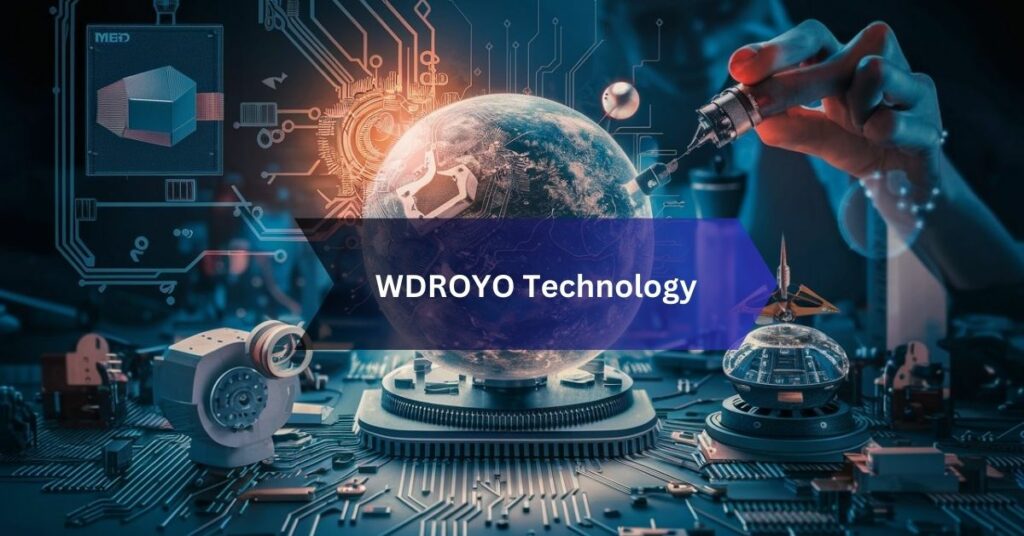WDROYO (Wave Driven Reactive Observation Yielding Output) technology is a cutting-edge innovation in the field of human-computer interaction.
By monitoring neural activity, WDROYO systems can understand user intent with remarkable accuracy, enabling seamless interaction with digital devices and applications.
Significance and Impact
The significance of WDROYO technology lies in its transformative potential across various domains. By eliminating the need for physical input devices, WDROYO opens up new possibilities for hands-free computing, immersive virtual experiences, and enhanced accessibility for individuals with disabilities.
Moreover, WDROYO has the potential to revolutionize industries ranging from healthcare to manufacturing. In healthcare, WDROYO technology enables precise diagnostics, personalized treatment plans, and early disease detection through advanced brain imaging and analysis.
Historical Context: Origins and Development
1. Emergence of WDROYO Technology
The emergence of WDROYO (Wave Driven Reactive Observation Yielding Output) technology can be traced back to the intersection of neuroscience, artificial intelligence, and human-computer interaction.
The seeds of this groundbreaking innovation were planted in the quest to create more intuitive and seamless interfaces that transcend the limitations of traditional input devices.
Initially, researchers and innovators sought to understand the intricacies of neural oscillations and how they could be harnessed to interpret human intentions.
2. Evolution of WDROYO over Time

The evolution of WDROYO technology has been marked by continuous refinement and innovation, driven by the relentless pursuit of enhancing user experience and functionality.
From its nascent stages as experimental prototypes to its current state as a commercially viable solution, WDROYO has undergone significant evolution over the years.
Early iterations of WDROYO focused primarily on basic brain-computer interfaces, demonstrating proof-of-concept applications in fields such as neurofeedback and assistive technology for individuals with disabilities.
Core Principles and Functionality
At the heart of WDROYO (Wave Driven Reactive Observation Yielding Output) technology lie fundamental principles that govern its operation and functionality. These principles are rooted in neuroscience, artificial intelligence, and signal processing, enabling WDROYO systems to interpret human brain activity and translate it into actionable commands. The core principles of WDROYO include:
- Neural Oscillation Analysis: WDROYO technology relies on the analysis of neural oscillations, which are rhythmic patterns of electrical activity in the brain. By monitoring these oscillations, WDROYO systems can decipher the user’s intentions and desires with remarkable accuracy.
- Real-time Data Processing: WDROYO systems employ sophisticated algorithms for real-time data processing. By continuously analyzing incoming brainwave data, WDROYO can generate instant responses and adapt to changes in the user’s cognitive state.
- Pattern Recognition: Central to WDROYO’s functionality is its ability to recognize patterns in brainwave activity. Through advanced machine learning techniques, WDROYO systems can identify subtle cues and correlations in neural signals, enabling precise interpretation of user intent.
- Adaptive Learning: WDROYO technology is designed to adapt and learn from user interactions over time. By leveraging neural networks and deep learning algorithms, WDROYO systems can improve their accuracy and responsiveness with experience, enhancing the overall user experience.
Recent Innovations in WDROYO
Recent years have witnessed significant advancements in WDROYO technology, driven by ongoing research and development efforts aimed at unlocking new capabilities and expanding its applications. Some of the notable innovations in WDROYO include:
- Enhanced Neural Network Architectures: Researchers have developed advanced neural network architectures specifically tailored for WDROYO applications. These networks are optimized for processing and interpreting complex brainwave patterns, resulting in improved accuracy and reliability.
- Multimodal Integration: Recent innovations in WDROYO technology have focused on integrating multiple modalities of input, such as EEG (electroencephalography) data, eye-tracking, and facial expressions. By combining these modalities, WDROYO systems can achieve a more comprehensive understanding of the user’s cognitive state.
- Real-time Feedback Mechanisms: To enhance user engagement and performance, WDROYO systems now incorporate real-time feedback mechanisms. These mechanisms provide users with immediate feedback on their cognitive states, enabling them to better control and modulate their brain activity.
- Context-aware Adaptation: Another recent innovation in WDROYO technology is context-aware adaptation. WDROYO systems can now dynamically adjust their behavior based on contextual cues such as the user’s environment, task at hand, and emotional state, ensuring a more personalized and adaptive user experience.
Overall, these recent innovations have propelled WDROYO technology to new heights, paving the way for a future where seamless interaction between humans and machines is not only possible but also intuitive and effortless.
Exploring Applications Across Industries

1. Healthcare Applications
WDROYO (Wave Driven Reactive Observation Yielding Output) technology is making significant strides in healthcare. It enables precise diagnostics by analyzing brainwave patterns, leading to early detection of diseases like epilepsy and Alzheimer’s. Moreover, it facilitates personalized treatment plans and aids in neurorehabilitation through brain-computer interfaces for patients with motor impairments.
2. Manufacturing and Industrial Use Cases
In manufacturing, WDROYO optimizes processes by monitoring operator brainwaves, identifying bottlenecks, and enhancing productivity. It also improves quality control by detecting anomalies in brainwave patterns, ensuring consistent product quality. Additionally, WDROYO contributes to worker safety by detecting signs of fatigue or stress among employees.
3. WDROYO in Finance and Retail
In finance, WDROYO analyzes customer brainwave data to offer personalized financial services and enhance fraud detection. In retail, it enhances customer engagement through immersive shopping experiences and aids in fraud detection by analyzing changes in customer behavior. WDROYO also plays a role in risk assessment, helping financial institutions identify suspicious transactions.
User Experience and Benefits
1. Importance of User Experience
User experience (UX) is paramount in today’s digital landscape. It encompasses the overall experience a user has when interacting with a product or service, including ease of use, intuitiveness, and satisfaction. Prioritizing UX is crucial for businesses seeking to differentiate themselves in competitive markets and foster customer loyalty.
2. Advantages of Traditional Technologies
Traditional technologies, while often overshadowed by newer innovations like WDROYO, offer distinct advantages in various contexts. They are often more reliable, compatible with existing systems, and familiar to users. Additionally, traditional technologies can be cost-effective solutions for businesses, providing stability and efficiency where needed.
3. Integration of WDROYO for Enhanced User Experience
The integration of WDROYO technology into existing systems can significantly enhance user experience in several ways. By harnessing the power of neural oscillations, WDROYO enables more intuitive and seamless interactions with digital devices and applications. Users can control devices and access information using their thoughts alone, eliminating the need for physical input devices.
Industry Perspectives and Case Studies
1. Successful Implementations of WDROYO
In recent years, WDROYO (Wave Driven Reactive Observation Yielding Output) technology has garnered significant attention across industries for its potential to revolutionize human-computer interaction. Successful implementations of WDROYO have demonstrated its versatility and effectiveness in addressing diverse challenges. These implementations span various sectors, showcasing the transformative impact of WDROYO technology.
Addressing Challenges and Ethical Considerations

As WDROYO (Wave Driven Reactive Observation Yielding Output) technology continues to advance, it is essential to address various ethical dilemmas and societal concerns to ensure responsible deployment and usage. Addressing these challenges is crucial for building trust, safeguarding privacy, and mitigating potential risks associated with WDROYO technology.
1. Ethical Dilemmas in WDROYO Technology
One of the primary ethical dilemmas in WDROYO technology revolves around issues of privacy, consent, and autonomy. Collecting and analyzing sensitive brainwave data raises concerns about individual privacy and the potential for unauthorized access or misuse of personal information. Additionally, questions arise regarding the ethical implications of using WDROYO to influence or manipulate human behavior, such as in advertising or political campaigns.
2. Societal Impact and Mitigation Strategies
The societal impact of WDROYO technology extends beyond individual privacy concerns to broader implications for employment, inequality, and human rights. As WDROYO systems automate tasks and replace traditional roles, there is a risk of job displacement and widening socioeconomic disparities. To mitigate these impacts, organizations must prioritize retraining and reskilling programs to ensure that workers are equipped with the skills needed for the digital economy. Additionally, implementing policies that promote fairness, transparency, and accountability in WDROYO deployment can help mitigate potential societal risks and ensure equitable access to benefits.
3. Privacy Concerns and Data Protection
Privacy concerns are paramount in the development and deployment of WDROYO technology. Collecting and analyzing brainwave data raise significant privacy implications, as this data can reveal intimate details about an individual’s thoughts, emotions, and cognitive processes. To address these concerns, organizations must implement robust data protection measures, such as encryption, access controls, and anonymization techniques, to safeguard sensitive information from unauthorized access or disclosure. Additionally, transparent data practices and clear consent mechanisms are essential for ensuring that individuals have control over how their data is collected, used, and shared.
4. Regulatory Compliance and Legal Implications
Navigating complex regulatory landscapes, such as GDPR (General Data Protection Regulation), is essential for organizations developing and deploying WDROYO technology. Compliance with data protection laws and regulations is not only a legal requirement but also critical for maintaining trust with stakeholders and avoiding potential legal repercussions. Organizations must stay updated on evolving regulatory requirements and ensure that their WDROYO systems adhere to applicable laws governing data use, privacy, and ethical standards
Frequently Asked Questions (FAQs)
1. How Does WDROYO Benefit Industries?
In healthcare, it enables precise diagnostics and personalized treatment plans, while in manufacturing, it streamlines processes and optimizes quality control.
2. Is WDROYO Accessible To Small Businesses?
Yes, WDROYO technology offers scalable solutions that are accessible to businesses of all sizes. While initial implementation may require investment in specialized hardware and software, the long-term benefits, including improved efficiency and customer satisfaction, outweigh the initial costs.
3. How Secure Is WDROYO For Storing Sensitive Data?
By adhering to best practices in data security and privacy, WDROYO systems ensure that user data is protected from unauthorized access or misuse.
4. What Are The Ethical Considerations With WDROYO?
Collecting and analyzing brainwave data raise questions about individual privacy rights and the potential for unauthorized access or misuse of personal information.
Conclusion
In conclusion, WDROYO (Wave Driven Reactive Observation Yielding Output) technology represents a paradigm shift in human-computer interaction, offering unprecedented levels of control, personalization, and efficiency. Throughout this article, we have explored the origins, applications, challenges, and ethical considerations of WDROYO, highlighting its transformative impact across various industries.
Read:
